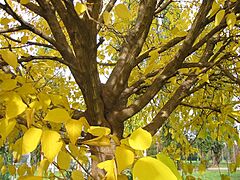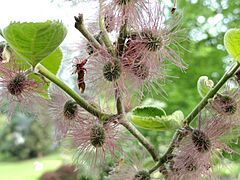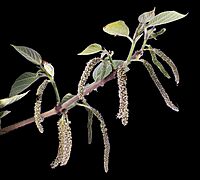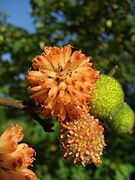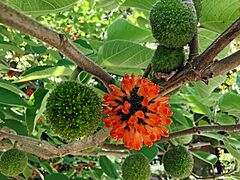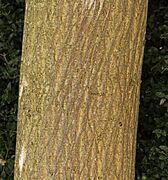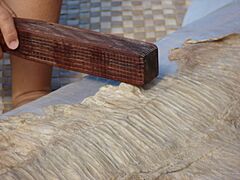Paper mulberry facts for kids
Quick facts for kids Paper mulberry |
|
|---|---|
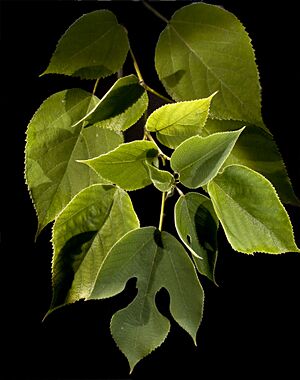 |
|
| Conservation status | |
| Scientific classification | |
| Synonyms | |
|
| Paper mulberry | |||||||
|---|---|---|---|---|---|---|---|
| Traditional Chinese | 構樹 | ||||||
| Simplified Chinese | 构树 | ||||||
|
|||||||
The paper mulberry (Broussonetia papyrifera) is a special type of flowering plant in the Moraceae family. It's originally from Asia, including places like China, Japan, Korea, and India. Today, you can find it growing in many other parts of the world, like New Zealand, Europe, the United States, and Africa. People also call it aute or the tapa cloth tree.
Contents
What is the Paper Mulberry?
The paper mulberry is a fascinating plant with a long history. It has been super important to many cultures for centuries. People have used it to make clothes, paper, and even medicine. It's a plant that connects us to ancient traditions and clever inventions!
Where Does it Come From?
This tree first grew in the warm, subtropical areas of mainland Asia. Ancient people, especially those from the Austronesian cultures, discovered its amazing uses. They carried the paper mulberry with them as they explored and settled islands across the Pacific Ocean. This helped the tree spread from places like Taiwan to distant islands like New Guinea and beyond.
The paper mulberry was brought to New Zealand by early Māori settlers. It was important for making cloth. However, over time, its use decreased, and animals like pigs and cattle ate the trees. Later, during colonial times, it was brought back to New Zealand from Japanese plants.
How Does it Look?
The paper mulberry is usually a deciduous shrub or tree. This means it loses its leaves in certain seasons. It typically grows about 10–20 m (33–66 ft) tall, but some can reach up to 35 m (115 ft)!
Its leaves can look different even on the same tree. They might be smooth or have deep cuts, but they always have jagged edges. The undersides are usually pale and a bit fuzzy. The leaves can grow up to 15–20 cm (5.9–7.9 in) long.
This tree has separate male and female plants. The male flowers grow in fuzzy, long clusters called catkins, up to 8 cm (3.1 in) long. The female flowers are small, greenish, and form a round head about 2 cm (0.79 in) wide. After flowering, the female plants produce a round cluster of many small, red or orange fruits, about 2–3 cm (0.79–1.18 in) wide. Each tiny fruit in the cluster is called a drupe.
Amazing Uses of Paper Mulberry
For hundreds of years, people in Asia and the Pacific Islands have grown the paper mulberry. They used it for food, fiber, and even traditional remedies.
Making Cloth from Bark
One of the most famous uses of the paper mulberry is making barkcloth. In many Polynesian languages, this cloth is called tapa. People carefully peel the inner bark from the tree. Then, they beat it with special stone or wooden tools until it becomes a soft, flexible fabric.
Barkcloth was very important for clothing in ancient times. It was also used for bags and bedding. Today, while most people wear woven clothes, barkcloth is still used for special ceremonies in parts of Polynesia and Melanesia.
In New Zealand, early Māori settlers also made barkcloth, which they called aute. By the 1770s, it was mainly used for soft, white headbands or ear decorations for important men. The art of making aute almost disappeared, but there's new interest in bringing this ancient craft back to life.
A Tree for Paper
The paper mulberry has played a huge role in the history of paper. Its fibers are known for being strong and lasting a very long time. This makes it perfect for high-quality paper.
People in China started using it for papermaking between the 2nd and 8th centuries. In Korea, the oldest known block print, from around 751 AD, was made on hanji paper using paper mulberry fibers. Today, both Korean Hanji and Japanese Washi papers are often made from the inner bark of this tree. The bark is pounded, mixed with water, and then dried into sheets.
Other Cool Uses
- Wood: The wood from the paper mulberry is used to make furniture and kitchen tools.
- Roots: Its strong roots can be twisted together to make rope.
- Food: The fruits are edible, and the leaves can be cooked and eaten.
- Medicine: In some traditional health systems, parts of the plant, like the bark and fruit, were used as remedies. For example, they were used to help with digestion or to reduce fevers.
- Landscaping: Because it can handle pollution and tough conditions, it's sometimes planted along roadsides. It's also a "pioneer species," meaning it's one of the first plants to grow in empty forest areas, helping new forests start.
A Plant That Spreads Easily
The paper mulberry is very good at growing in new places, especially in areas that have been disturbed. This ability can sometimes make it an invasive species. When male and female plants grow together, they produce many seeds. Animals eat the fruits and spread the seeds. Also, its root system can spread widely, creating dense patches of trees.
In some regions, it has become a serious problem. For example, it's considered one of the worst weeds in Pakistan. It's also a major invasive plant in parts of Argentina and Uganda.
Watch Out for Pollen!
The pollen from the paper mulberry can cause allergies. In cities like Islamabad, where the tree is very common, its pollen is a main cause of breathing problems and asthma. Every March, thousands of people go to hospitals because of pollen allergies from this plant. It's important to think carefully before planting male paper mulberry trees in new areas, because of the pollen they release.
Images for kids
See also






